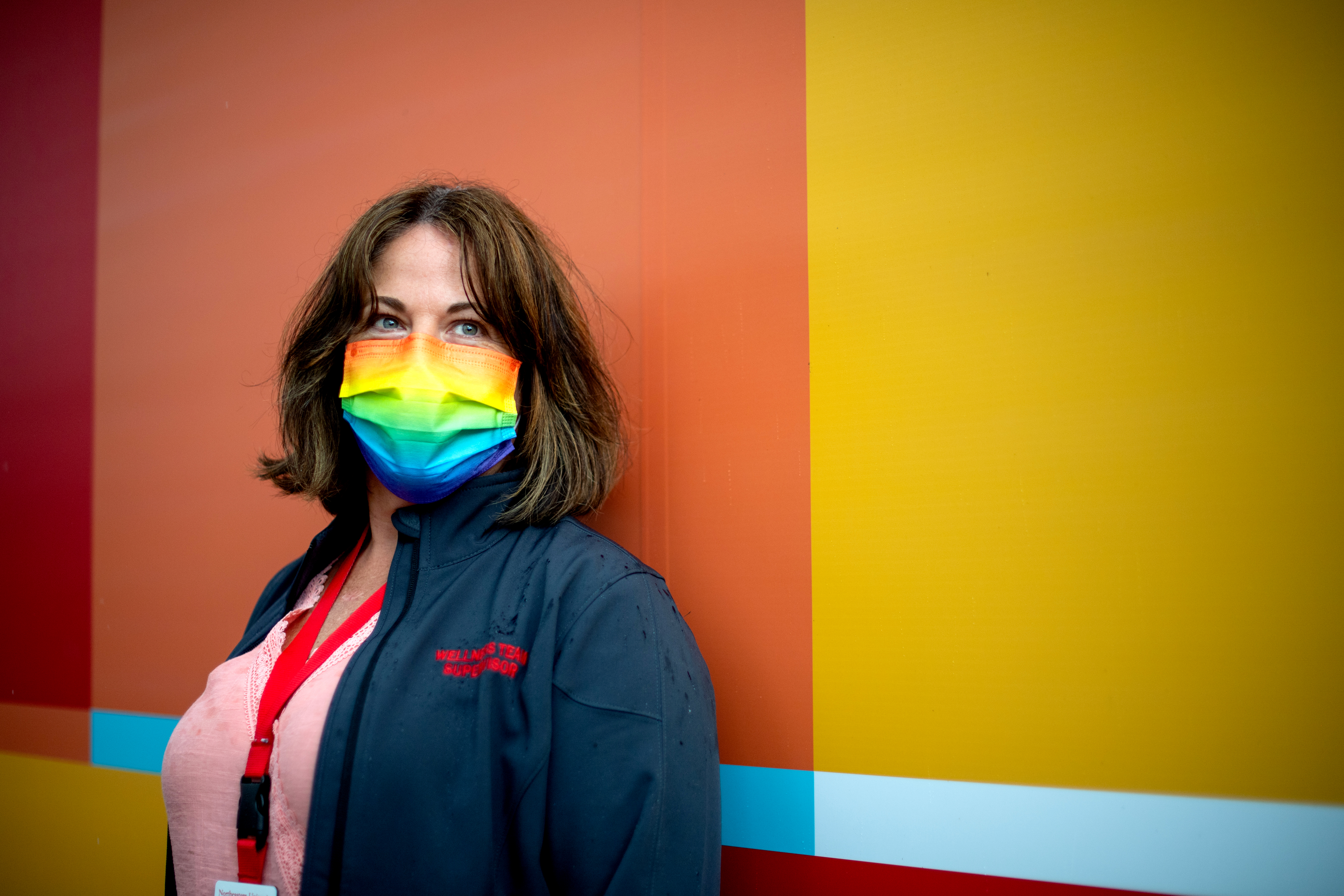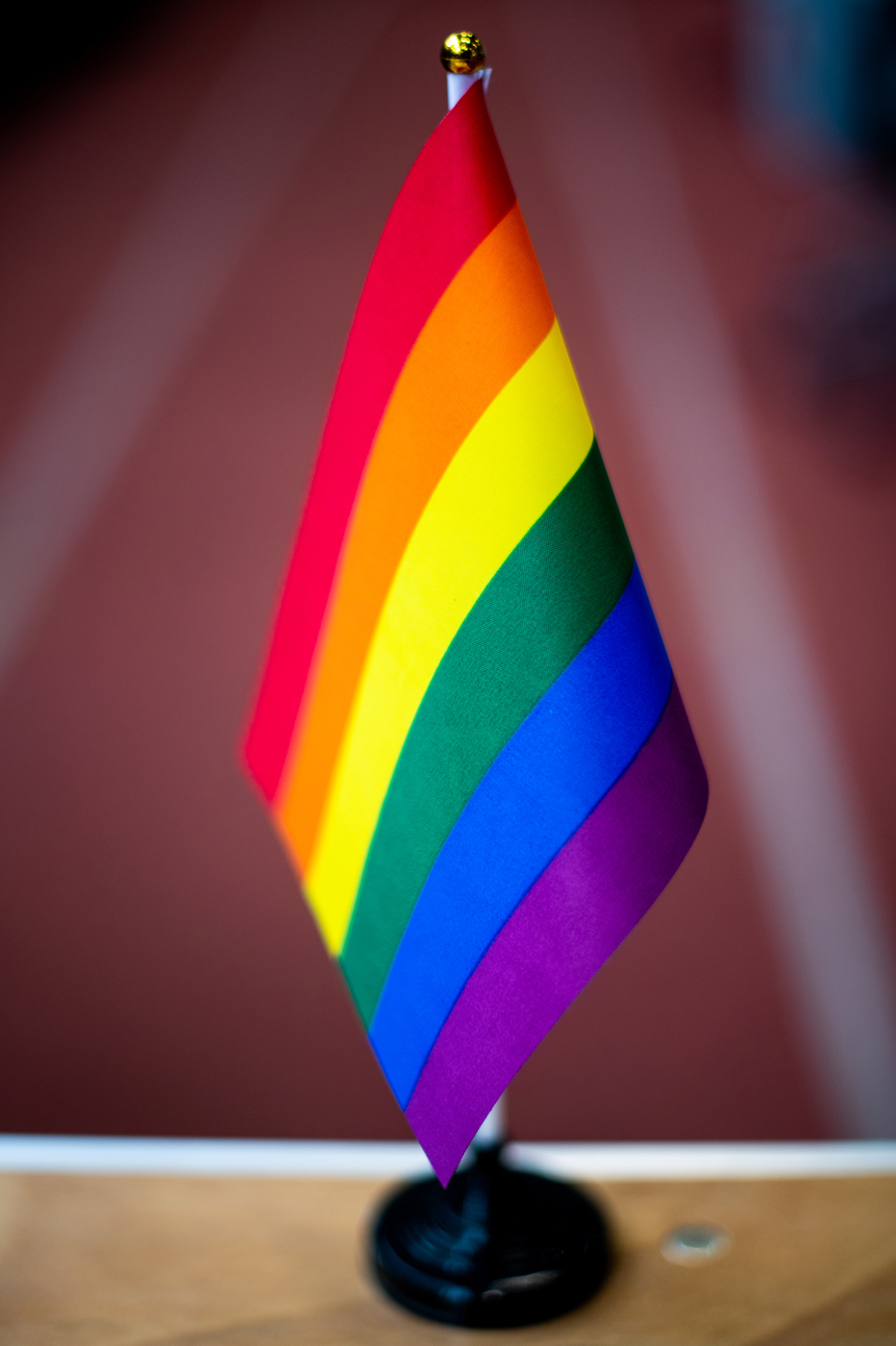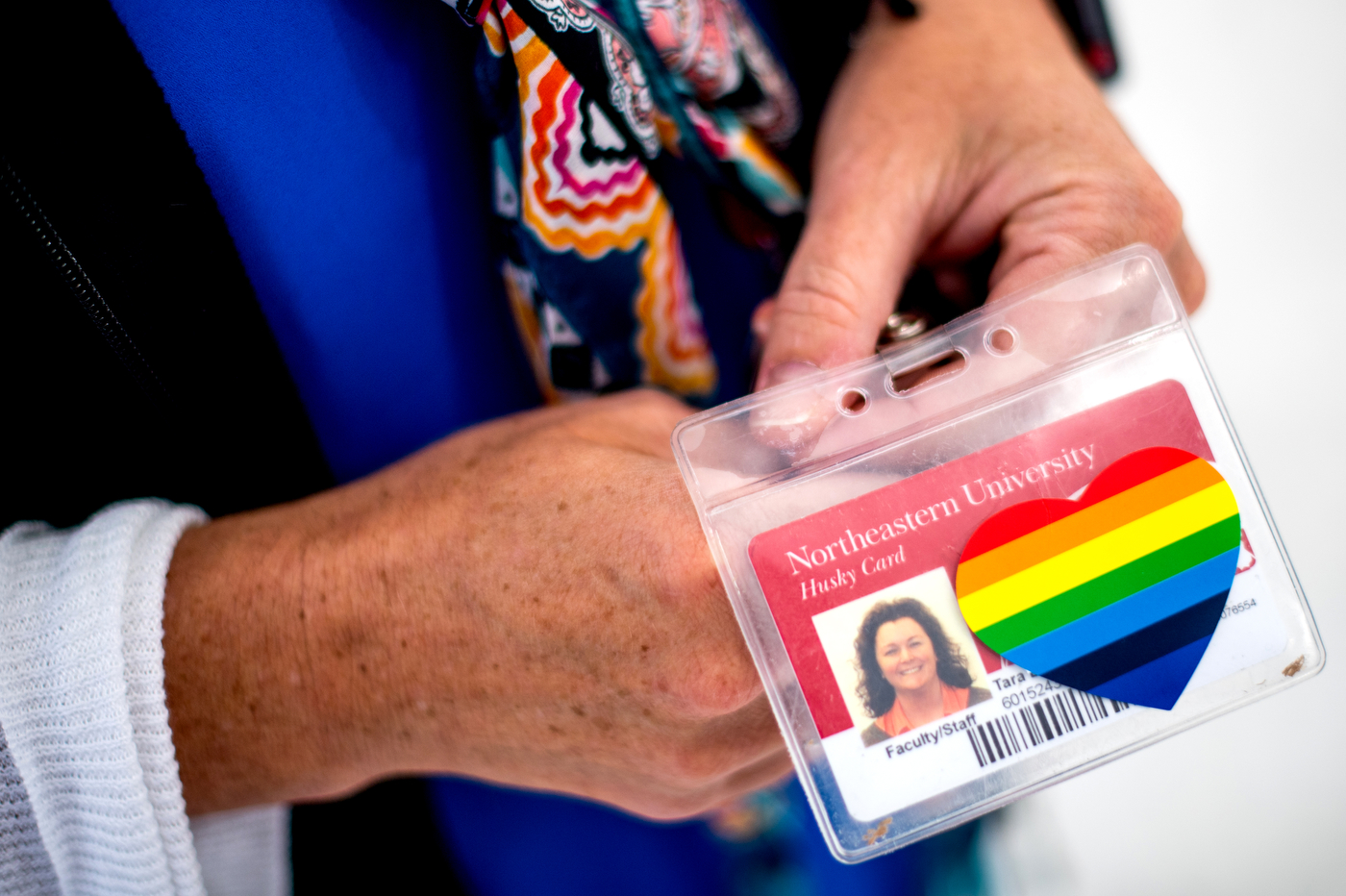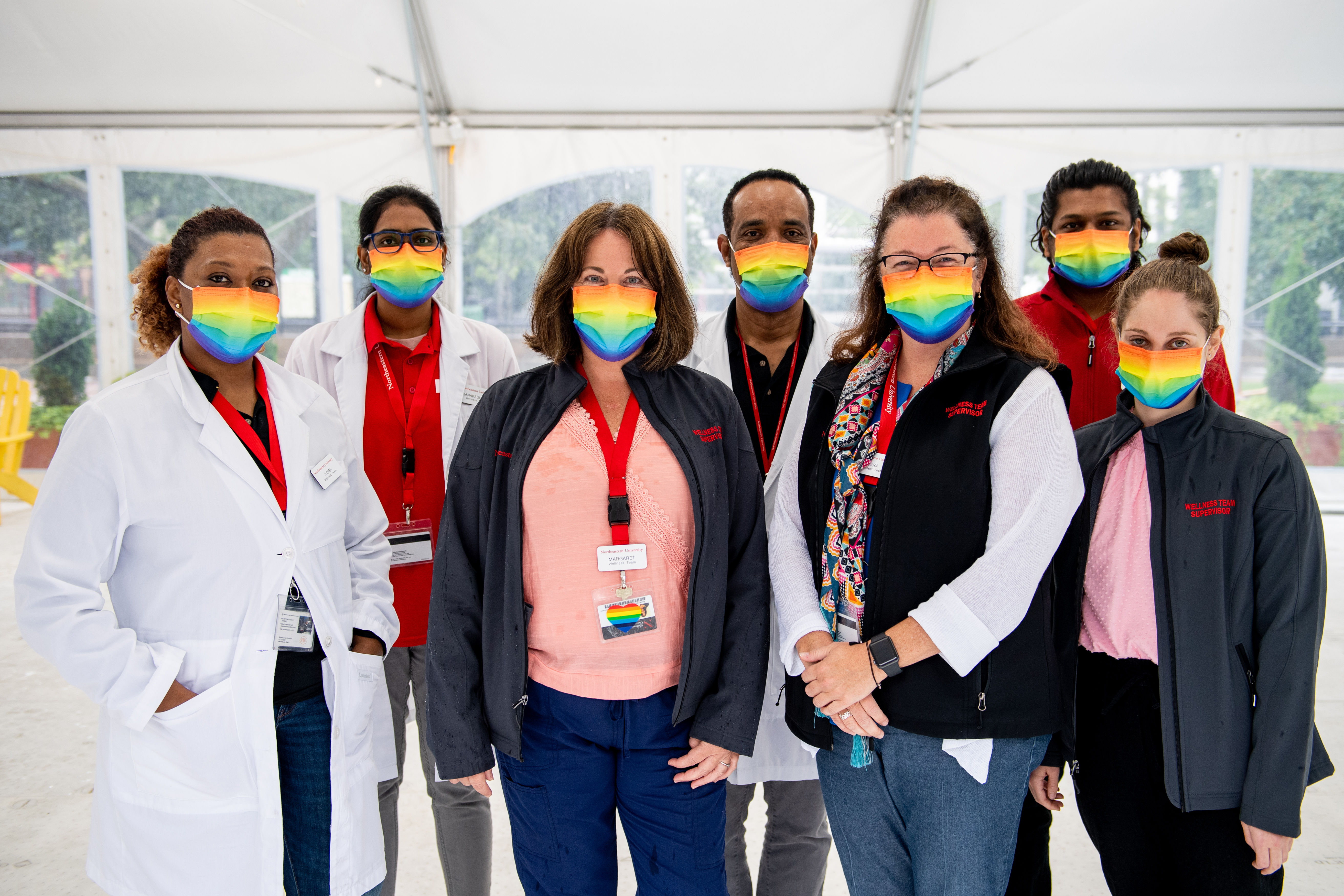Employees at Northeastern’s COVID-19 testing centers celebrate LGBTQA Pride Month

It’s hard to see a smile through a face mask, but at Northeastern’s Cabot Testing Center, you just know they’re there. The COVID-19 testing center, which has been scaled down recently as cases of the disease drop and vaccinations rise, is awash this month in rainbow flags, stickers, and face masks to celebrate LGBTQA Pride Month.
“We hope it puts a smile on people’s faces; we wanted to do something to uplift the campus,” says Margaret Bennette, a site supervisor at the testing center who donated a number of rainbow-hued disposable masks for her staff to wear.
Celebrated in June in the United States, LGBTQA Pride Month is a time to honor the 1969 Stonewall Uprising, which served as a tipping point for the gay liberation movement. The rainbow flag has become synonymous with the LGBTQA community, with its array of colors representing various different identities.
The Cabot team worked with Northeastern’s LGBTQA Resource Center to acquire Pride flags to decorate the testing center and stickers to hand out to students, faculty, and staff stopping by to get tested, says Sehyo Yune, assistant vice chancellor for the COVID-19 wellness team.

And this month, Bennette says, there is a lot to celebrate. In accordance with public health guidelines from the U.S. Centers for Disease Control and Prevention, members of the Northeastern community who are fully vaccinated will no longer need to participate in weekly surveillance testing for SARS-CoV-2, the coronavirus that causes COVID-19.
The change, which follows a number of other lifted restrictions across the country, is an indication that the pandemic may finally be waning in the U.S.
“It feels like we’re finally able to lift our heads up, we’re finally able to look around and celebrate,” Bennette says. “We’re so grateful for the patience and understanding of the Northeastern community throughout the last year, and now we can celebrate.”
The Cabot and Huntington testing centers—the latter used for symptomatic testing—were constructed at hyper speed during the summer of 2020 and became the cornerstone of Northeastern’s reopening strategy.
“In July or so, we started having conversations about coming back for in-person learning in the fall,” says Jim Brand, director of space and capital planning. “Testing basically came down to a series of math problems: How many people do you need to test, how often, how long will it take to test each person, and how much space do you need to do that?”
Brand and other university officials modeled several different testing configurations to find the safest and most efficient plan for the Boston campus. They considered a decentralized model that included a handful of smaller testing sites spread across campus, and ultimately narrowed it down to Cabot for asymptomatic surveillance testing and Huntington for symptomatic testing.
The university’s models indicated that it could test 5,000 people per day at Cabot, with some room still to scale up if needed—a conclusion that was confirmed by an outside engineering firm, Brand says.
But models are one thing; actually testing people in Cabot cage was going to be entirely different.



“You know, it’s a big, open, unsophisticated gym,” Brand says. “We had to bring in power, internet connectivity, wireless coverage, outside cooling, ventilation, a backup generator in case everything went down—and that’s just scratching the surface.”
It was a daunting task, and one that required innovation and hard work from almost every department across the university, Brand says.
Gerard Buggy, senior project manager in campus design and construction, was one of the people who oversaw the construction of the Cabot and Huntington testing centers.
“Everything about a ‘regular day’ was out the window with these two projects,” he says. “It was a real exercise in group management and good communication. We had to get things done quickly, and everyone had their eye on the prize.”
Buggy says he met people during the creation of these testing centers that he’d never known before—some of whom he ended up working with at all hours of the day.
With 30 days left before the testing centers needed to open, teams of university staff and contractors were working around the clock to secure new heating and cooling systems, an emergency power system, a temporary floor, and a set of stanchions—the rope system that delineates waiting areas inside Cabot—that the university picked up after an NFL team canceled their order at the last minute.
And at Huntington, things were even more complicated. Because the facility would be used to test people suspected of having COVID-19, the office space had to be converted into a medical-caliber testing facility, Buggy says.
Teams removed the heating and ventilation systems and replaced them with a newly designed system that would allow for 100 percent of the air to be pumped in from the outside, without being recycled through the space.
“That space is like a little submarine that lives within the building,” Buggy says. “None of the air mixes at all.”
It required specialty equipment that wasn’t readily available, and the university relied upon its network of contractors to procure it, he says.
“We got all this equipment from all over the country within three weeks,” Buggy says. “Meanwhile, it took me five weeks to get a new refrigerator delivered for my home, and they’re down the street.”
Buggy says he spent “a lot of sleepless nights” worrying about whether the equipment would arrive on time, and whether the projects would get done in time for the campus to reopen.
It did, of course, and in no time, thousands of people were filtering through Cabot every day on their way to work or class. In less than a year, the testing centers, along with the Life Sciences Testing Center in Burlington, Massachusetts, processed more than one million COVID-19 tests.
“There’s a point in every project where you look at it and say, ‘This is really something.’ And in this case, we couldn’t have done it without everyone jumping in and asking what they could do to help,” he says.
Bennette was among the first wave of people hired to make the newly constructed testing centers actually run. She started out as a swab coach, teaching other employees how to properly instruct students, faculty, and staff to swab their noses for evidence of SARS-CoV-2.
She’s been promoted twice since then, and now supervises a staff of students and professional staff who are the lifeblood of the Cabot Testing Center.
“You just had to be on your toes and be ready for anything to happen in any area of that gymnasium,” she recalls. “We had to stay vigilant.”
Staff banded together, often leaning on each other for support during a challenging year, Bennette says.
“We became a family,” she says, adding that her biggest sense of pride was born of witnessing student-employees—often first-year students who were new to the university and Boston altogether—grow and learn on the job.
Rohit Datir, a computer science student, was among the veritable flotilla of student-employees hired to facilitate testing at Cabot. During the quarantine days of the pandemic, the testing center became an unlikely place for him to meet new people and make new friends, he says.
“I just learned so much, and got to interact with so many different people at the university,” Datir says.
Now that the long days of uncertainty and isolation are largely over in the U.S., Datir, Bennette, and their colleagues say it’s a bittersweet feeling.
“When we first started, we had this mission to ‘Protect the Pack,’” Bennette says. “That was our mission, that’s how we got through the day. And we can look back on our time at Cabot and know that our legacy was a positive part of this pandemic. We can all be proud of that.”
For media inquiries, please contact media@northeastern.edu.





